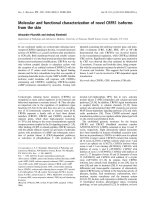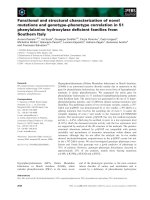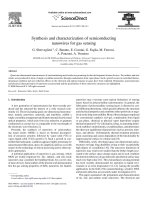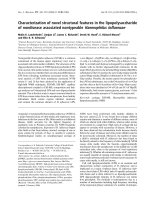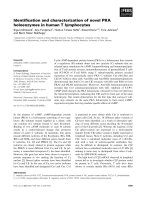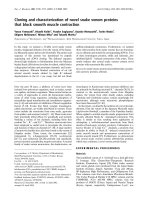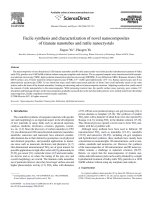synthesis and characterization of novel polymers for functional and stimuli responsive silicon surfaces
Bạn đang xem bản rút gọn của tài liệu. Xem và tải ngay bản đầy đủ của tài liệu tại đây (2.88 MB, 290 trang )
SYNTHESIS AND CHARACTERIZATION OF
NOVEL POLYMERS FOR FUNCTIONAL AND
STIMULI RESPONSIVE SILICON SURFACES
Kalpana Viswanathan
Dissertation submitted to the Faculty of the Virginia Polytechnic Institute and State
University in Partial Fulfillment of the Requirements for the Degree
Doctor of Philosophy
In
Chemistry
Virginia Polytechnic Institute and State University
Submitted to:
Thomas C. Ward, Chair
Timothy E. Long
Alan R. Esker
Judy S. Riffle
Richey M. Davis
April 7, 2006
Blacksburg, Virginia
Keywords: Silicon surface modification, star-branched polymers, amphiphilic block
copolymers, responsive surfaces, multiple hydrogen bonding
Copyright 2006, Kalpana Viswanathan
UMI Number: 3207992
3207992
2006
UMI Microform
Copyright
All rights reserved. This microform edition is protected against
unauthorized copying under Title 17, United States Code.
ProQuest Information and Learning Company
300 North Zeeb Road
P.O. Box 1346
Ann Arbor, MI 48106-1346
by ProQuest Information and Learning Company.
Synthesis and Characterization of Novel Polymers for
Functional and Stimuli Responsive Silicon Surfaces
Kalpana Viswanathan
ABSTRACT
The use of polymers as surface modifiers enables control over many variables
such as film thickness, chemical composition and areal density of functional groups. The
synthesis of a variety of novel functionalized polymers using living polymerization
techniques to achieve functional and stimuli responsive coatings on silica surfaces are
described. Since microscopic features on a surface influence the overall wetting
properties of the surface, a systematic investigation of the influence of polymer
architecture on the microscopic characteristics of the modified surfaces was studied using
silane-functionalized linear and novel star-branched polystyrene (PS). Star-branched
modifiers provide functional and relatively well-defined model systems for probing
surface properties compared to ill-defined highly branched systems and synthetically
challenging dendrimers. Using these simple star-shaped macromolecules it was shown
that the topographies of the polymer-modified surfaces were influenced by the polymer
architecture. A model explaining the observed surface features was proposed.
A living polymerization strategy was also used to synthesize centrally
functionalized amphiphilic triblock copolymers, where the central functionalized block
covalently anchored the copolymers to silica surfaces. The amphiphilic copolymers
exhibited stimuli responsive changes in surface hydrophobicity. In spite of multiple
solvent exposures, the copolymer films remained stable on the surface indicating that the
observed changes in surface properties were due to selective solvent
iii
induced reversible rearrangement of the copolymer blocks. The chemical composition
of the copolymers was tailored in order to tune the response time of the surface anchored
polymer chains. Thus, the polymer coatings were used to reversibly change the surface
polarities in an on-demand fashion and could find possible applications as smart
adhesives, sensors and reusable membrane devices.
In contrast to the afore-mentioned covalent modification approach, which often
leads to permanent modification of surfaces, renewable surfaces exhibiting “universal”
adhesion properties were also obtained through non-covalent modification. By
employing hydrogen bonding interactions between DNA bases, surfaces functionalized
with adenine groups were found to reversibly associate with thymine-functionalized
polymers. This study describing the solvato-reversible polymer coating was the first
demonstration on silica surfaces. A systematic investigation of the influence of surface
concentration of the multiple hydrogen bonding groups and their structure on the extent
of polymer recognition by the modified surfaces is also presented.
iv
Acknowledgements
I would like to express my sincere thanks and gratitude to my advisors Dr.
Timothy E. Long and Dr. Thomas C. Ward for their encouragement and support
throughout my graduate school years here at Virginia Tech. Dr. Long, thank you for
providing me the opportunities for expressing my ideas and all the memorable group
trips! I am extremely grateful to Dr. Ward for his unfailing confidence in me and my
ability as a scientist. I would also like to extend my gratitude to members of my
committee for their interest and valuable guidance. Thanks to Dr. Cheryl Heisey for her
enormous help in proofreading my grammatically flawed manuscripts and making them
readable.
I would like to thank all the analytical staff, in particular Mr. Tom Glass, Mr.
Frank Cromer and Mr. Steve McCartney. The help and thoughtfulness of all the staff
members, in particular Ms. Laurie Good, Ms. Millie Ryan, Ms. Esther Brann, Ms.
Tammy Jo Hiner, Mr. Tom Wertalik, Ms. Jan McGinty and everybody in the stock room
Sue, Ernie, Debbie, Gary is gratefully acknowledged.
Life in graduate school would not have been as good if not for the help and
encouragement of fellow graduate students. I would like to acknowledge Dave, Lars,
Qin, Emmett, Sandra, Amy, Tomonori, Sharlene, Serkan, Gözde, Jeremy, Scott, Matt,
Matthew, John, Rebecca, Matt Hunley, Andy, Erica, Hailing, and Jamie for their many
help and suggestions all along. I would especially like to thank Casey for the many
volatile but funny discussions, for keeping track of my swearing tally and for initiating
me into the happy hour tradition, Brian for extensive help scientifically and the many
encouraging words, and Ann for all the helpful discussions (will never forget the little
skirmish on our way back from Eastman!). I do not have sufficient words to thank Afia,
for the many good times in the lab and outside that will stay in my memories for years to
come. Thank you for cheering me up when the going got tough, for listening with patient
ears to all my whining and above all for being such a wonderful friend!!!
The many help and encouragement of other graduate students, in particular Min,
Ufuk, Aziz, Ritu, Chris, Brian, Avijitha are greatly appreciated. I was fortunate to work
v
with two extremely outstanding undergraduates, Hayriye and Emily, who brought in
some new perspectives to my research. I wish them all the very best in their careers.
My friends, Archana, Phani, Pranitha, Manish, Smita, Mansi, Lakme, Vyas,
Gunjan, Supriya, Bindu, Siddharth, Pramod, Jaya, Maria and all others made my stay in
Blacksburg enjoyable. Thank you all for being there when I needed you and for all the
happy moments that I will cherish forever! I would not be in Virginia Tech if not for my
friends from MSc, in particular Sukunath, Vasu, Ramya, Karthik and Vidya. Dr. R.
Dhamodharan at IIT, Madras got me interested in polymers, and am greatly indebted to
him for his guidance and support during my stay at IIT. All the help of my fellow
labmates, in particular Mohammed and Raja is gratefully acknowledged.
I would not be the person that I am today if not for my wonderful family. My
parents have always stood by my decisions and provided me all the resources even in
difficult times to help me achieve my goals and realize my dreams. Their love and
confidence has kept me going even in times of distress. I am fortunate to have very
understanding and caring grandparents, sisters, brothers, brothers-in-law, uncles, aunts,
and cousins who have helped me a great deal to mature as a person. Above all, I want to
thank God for providing me with all that I could ask for and more!
vi
Table of Contents
Chapter 1.0 Dissertation Overview
1
Chapter 2.0 Literature Review
3
2.1 Introduction to Surface Modification
3
2.2 Surface Modification with Polymers
4
2.21 Introduction
4
2.2.2 Physisorption of Polymers onto Surfaces
6
2.2.3 Polymer Attachment to Surfaces via “Grafting to” Approach
7
2.2.4 Polymer Attachment to Surfaces via “Grafting from” Approach
9
2.2.5 Electrostatic Adsorption of Polymers onto Surfaces
11
2.2.6 Conformations of Surface Attached Polymer Chains
13
2.3 Surface Modification with Branched Polymers
15
2.3.1 Introduction
15
2.3.2 Surface Modification with Dendrimers
15
2.3.3 Surface Modification with Hyperbranched Polymers
26
2.3.4 Surface Modification with Star-branched Polymers
31
2.4 Surface Modification with Block/Mixed Polymer Brushes
34
2.4.1 Introduction
34
2.4.2 Surface Modification with Amphiphilic Block Copolymers
38
2.4.3 Surface Modification with Mixed Polymer Brushes
45
2.5 Surface Modification with Molecular Recognition Groups Exhibiting
Non-covalent Associations
47
2.5.1 Introduction
47
2.5.2 Host-guest Interactions on Surfaces
50
2.5.3 Electrostatic Interactions on Surfaces
59
2.5.4 Hydrogen Bonding Interactions on Surfaces
66
Chapter 3.0 Silicon/SiO
2
Surface Modification with Novel Star-branched
Polymers Obtained thorough Hydrolysis and
Condensation of Trimethoxysilane-functionalized Polystyrene
84
3.1 Abstract
84
3.2 Introduction
85
3.3 Experimental
88
3.3.1 Materials
88
3.3.2 Polymer Characterization
89
3.3.3 Surface Characterization
89
3.3.4 Synthesis of Trimethoxysilane End-capped Polystyrene
90
3.3.5 Hydrolysis and Condensation of Trimethoxysilane-
Functionalized Polystyrene
90
3.3.6 Substrate Treatment
93
3.3.7 Polymer Thin Film Preparation
93
3.4 Results and Discussion
93
3.4.1 Influence of Polymer M
n
on Efficiency of
vii
Trimethoxysilane End-capping of PS
93
3.4.2 Hydrolysis and Condensation of Trimethoxysilane
End-capped PS
100
3.4.3 Synthesis of star-branched PS with Higher Arm Molecular
Weights
109
3.4.4 Silicon/SiO
2
Surface Modification with Linear and Star-
Branched PS
113
3.5 Conclusions
128
3.6 Acknowledgements
128
Chapter 4.0 Solvent Switchable Silicon Surfaces Obtained via Modification
with Novel Amphiphilic Block Copolymers
130
4.1 Abstract
130
4.2 Introduction
130
4.3 Experimental
135
4.3.1 Materials
135
4.3.2 Polymer Characterization
136
4.3.3 Surface Characterization
137
4.3.4 Synthesis of Poly(sty-b-styOAc-b-t-BA) (1)
137
4.3.5 Hydrazinolysis of Copolymer 1
139
4.3.6 Silylation of Copolymer 1-OH
140
4.3.7 Synthesis of Poly(sty-b-HEA-b-DMAAm) (2)
142
4.3.8 Substrate Treatment
143
4.3.9 Modification of Silicon/SiO
2
Surfaces with
Block Copolymers
143
4.3.10 Hydrolysis of Surface-grafted Copolymer 1-Si
145
4.3.11 Solvent Treatments of Copolymer-modified Surfaces
145
4.3.12 Kinetics of Block Rearrangement in Selective Solvents
146
4.4 Results and Discussion
146
4.4.1 Synthesis of Poly(sty-b-styOAc-b-t-BA) (1)
147
4.4.2 Hydrazinolysis of Copolymer 1
151
4.4.3 Silyaltion of Copolymer 1-OH
154
4.4.4 Synthesis of Copolymer 2
154
4.4.5 Silicon/SiO
2
Surface Modification with Copolymer 1-Si
160
4.4.6 Silicon/SiO
2
Surface Modification with Copolymer 2
168
4.5 Conclusions
178
4.6 Acknowledgements
178
Chapter 5.0 Multiple Hydrogen Bonding for Reversible Polymer-Surface
Adhesion
179
5.1 Abstract
179
5.2 Introduction
180
5.3 Experimental
185
5.3.1 Materials
185
viii
5.3.2 Material Characterization
185
5.3.3 Surface Characterization
186
5.3.4 Synthesis of Adenine-functionalized
Triethoxysilane (AIPTES)
186
5.3.5 Synthesis of Thymine-functionalized Polystyrene
(PS-thymine)
187
5.3.6 Substrate Treatment
190
5.3.7 Covalent Modification of Silicon/SiO
2
Surfaces
And Polymer Treatment
190
5.4 Results and Discussion
190
5.4.1 Synthesis of ADPTES and PS-thymine
190
5.4.2 Specific Recognition between PS-thymine and Silicon/SiO
2
Surfaces Modified with ADPTES mixture
197
5.4.3 Reversible Association between PS-thymine and Surfaces
Modified with ADPTES Mixture
209
5.5 Conclusions
212
5.6 Acknowledgements
212
Chapter 6.0 Hydrogen Bonding between Adenine-modified Surfaces and
Terminal Thymine-Functionalized Polystyrene: Influence
of Surface Adenine Concentration on Polymer Recognition
214
6.1 Abstract
214
6.2 Introduction
215
6.3 Experimental
219
6.3.1 Materials
219
6.3.2 Surface Characterization
219
6.3.3 Substrate Treatment
220
6.3.4 Covalent Modification of Silicon/SiO
2
Surfaces
220
6.3.5 PS-thymine treatment
221
6.4 Results and Discussion
221
6.4.1 Silicon/SiO
2
Surface Modification with ADPTES/DPPETES
Mixtures
223
6.4.2 Association between ADPTES/DPPETES-modified
Silicon/SiO
2
Surfaces and PS-thymine
230
6.4.3 PS-thymine Recognition by Silicon/SiO
2
Surfaces Modified
with Various Mixtures of ADPTES/MPTES
233
6.5 Conclusions
236
6.6 Acknowledgements
237
Chapter 7.0 DNA Base-pair Mediated Attachment of Methacrylate Random
Copolymers to Silicon/SiO
2
Surfaces
238
7.1 Abstract
238
7.2 Introduction
238
ix
7.3 Experimental
241
7.3.1 Materials
241
7.3.2 Material Characterization
241
7.3.3 Surface Characterization
242
7.3.4 Synthesis of Thymine-functionalized
Trimethoxysilane (TTMS)
242
7.3.5 Synthesis of Adenine-derivatized Methacrylate
Monomer (AIEMA) and Poly(EHMA-co-AIEMA)
243
7.3.6 Substrate Treatment
247
7.3.7 Modification of Silicon/SiO
2
Surfaces with TTMS
and Random Copolymers
247
7.4 Results and Discussion
247
7.4.1 Synthesis of TTMS
247
7.4.2 Synthesis of Poly(EHAM-co-AIEMA)
248
7.4.3 Silicon/SiO
2
Surface Modification with TTMS and
Poly(EHMA-co-AIEA)
254
7.4.4 Influence of Solvent on Poly(EHMA-co-AIEMA)
Attachment to thymine-modified Surfaces
261
7.5 Conclusions
265
7.6 Acknowledgements
265
Chapter 8.0 Overall Conclusions
267
Chapter 9.0 Suggested Future Work
270
9.1 Surface Modification with Branched Polymers
270
9.2 Switchable Surfaces Obtained through Modification with
Amphiphilic Block Copolymers
271
9.3 Multiple Hydrogen Bonding between Polymers and Surfaces
272
x
List of Figures
Figure 2-1: “Grafting to” approach depicting the attachment of
end-functionalized polymer chains to a surface functionality.
8
Figure 2-2: “Grafting from” approach depicting the growth of polymer chains
from surface attached initiating sites.
9
Figure 2-3: LBL deposition of alternating layers of anionic and cationic
polyelectrolyte multilayers on charged surfaces.
12
Figure 2-4: Depiction of polymer chains in the mushroom conformation (a),
and the brush conformation (b).
14
Figure 2-5: Synthesis of multihydroxyl functionalized dendritic hyperbranched
polymers on carbon nanotube surfaces by the “grafting from” approach.
Reprinted with permission from ( ref. 99). Copyright (2004) American Chemical
Society
31
Figure 2-6: Multiple hydrogen bond interactions between a) adenine/thymine
(double), b) diaminotriazine/thymine (triple), and c) ureidopyrimidones
(quadruple).
68
Figure 2-7: Formation of hydrogen-bonded multilayer thin films of PVP
and PAA. Reprinted with permission from (ref.203). Copyright (1999)
American Chemical Society.
74
Figure 3-1:
1
H NMR spectrum of oligomeric PS-Si(OMe)
3
.
95
Figure 3-2:
29
Si NMR analysis of PS-Si(OMe)
3
in 16 wt% CDCl
3
containing
0.06 M Cr(acac)
3
.
97
Figure 3-3:
1
H NMR spectra of PS-Si(OMe)
3
A) before, and B) after acid-
catalyzed hydrolysis and condensation.
102
Figure 3-4: Depiction of different environments around Si nucleus in
condensates obtained following hydrolysis and condensation of
trialkoxysilane-containing polymer.
104
Figure 3-5:
29
Si NMR analysis in 16 wt% CDCl
3
containing 0.06 M
Cr(acac)
3
of a) precursor linear PS oligomer, and b) star-branched PS.
105
xi
Figure 3-6: SEC DRI traces of a) precursor oligomer (M
w
= 4,790 g/mol), and
b) star-branched PS obtained by hydrolysis and condensation
(M
w
= 38,000 g/mol). Hydrolysis and condensation conditions: 20 wt% solids
in THF with [H
2
O]: [Si] ratio of 4 added as 1N HCl solution, 40 h stirring and
heated at 100 °C for 12 hours.
107
Figure 3-7:
1
H NMR spectra of PS-Si(OMe)
3
of M
n
= 10,000 g/mol following
hydrolysis and condensation.
110
Figure 3-8: SEC DRI traces of a) precursor oligomer (M
w
= 10,000 g/mol), and
b) branched PS obtained by hydrolysis and condensation
(M
w
= 48,300 g/mol). Hydrolysis and condensation conditions: 20 wt% solids
in THF with [H
2
O]: [Si] ratio of 4 added as 1N HCl solution, 40 h stirring
and heated at 100 °C for 12 hours.
112
Figure 3-9: Variation of chain grafting density with M
n
of PS-Si(OMe)
3
.
116
Figure 3-10: Tapping mode AFM topographic (a&b) and phase (c&d) images
on silicon/SiO
2
surfaces modified with linear (a&c) of M
w
= 17,000 g/mol
and star-branched (b&d) PS of M
w
= 18,500 g/mol, (height 0-10 nm, phase angle
= 0-20 deg). Both surfaces show an RMS roughness value of 0.28 nm. Surfaces
for AFM analysis were prepared by spin coating 1 wt% polymer solutions onto
clean silicon wafers, annealing polymer coated surfaces at 150 °C for 12 h and
extracting the physically attached polymers by sonication in toluene for 1 h.
119
Figure 3-11: Depiction of the formation of (a) brush regime in the case of linear
polymer chains, and (b) mushroom regime in the case of star-branched
polymers attaching to a solid surface.
121
Figure 3-12: Tapping mode AFM topographic (left) and phase (right)
images of a Si/SiO
2
surface modified with star-branched PS; M
w
= 22,700 g/mol
(scan area: 1 µm
2
, height: 0-10 nm; phase angle: 0-20 deg).
127
Figure 4-1:
1
H NMR spectra of A) PS-DEPN, B) P(sty-b-styOAc)-DEPN, and
C) poly(sty-b-styOAc-b-t-BA).
149
Figure 4-2:
1
H NMR spectra of 1 a) before hydrazinolysis (CDCl
3
), and
b) after hydrazinolysis (d
8
-THF).
152
Figure 4-3:
1
H NMR spectrum of poly(sty-b-styOAc-co-styOH-b-t-BA) following
reaction with IPTES.
155
Figure 4-4:
1
H NMR spectrum of poly(sty-b-HEA).
156
Figure 4-5:
1
H NMR spectrum of copolymer 2.
159
xii
Figure 4-6: XPS atomic composition of silicon/SiO
2
surfaces modified with
copolymer 1-Si before (0 h), and after (17 h & 24 h) hydrolysis.
161
Figure 4-7: Reversible changes in water contact angle (top) on copolymer 1-Si
modified silicon/SiO
2
surfaces following exposure to toluene (T), and methanol
(M); the blue and red lines indicate the water contact angles observed on neat
PS and PAA films. Error in contact angle measurements: ± 2°. Depiction of
block rearrangement following selective solvent exposures (bottom).
162
Figure 4-8: Kinetics of rearrangement of PS block after exposure to toluene
(top), and P(AA-co-t-BA) block after methanol exposure (bottom) at longer
times (a&c) and shorter times (b&d). Error in contact angle measurements: ± 2°.
166
Figure 4-9: Kinetics of reorganization of poly(AA-co-t-BA) containing block
(top), and PS block (bottom) in air.
167
Figure 4-10: Reversible changes in water contact following alternating
toluene and methanol exposures (first and last points correspond to solvent
exposure for 17 h). The dotted lines represent the water contact angle values
on neat PS (black) and PDMAAm (pink) films.
169
Figure 4-11: Kinetics of reorganization of PS and PDMAAm following
exposures to toluene and methanol, respectively.
170
Figure 4-12: Tapping-mode AFM phase images of copolymer 2 modified
silicon/SiO
2
surfaces in air a) before solvent treatment, b) after methanol
treatment, c) after THF treatment, d) after toluene treatment. (scan area = 1µm
2
,
phase angle = 0-25 deg).
174
Figure 5-1:
1
H NMR spectrum of adenine-functionalized triethoxysilane
(ADPTES).
192
Figure 5-2:
29
Si NMR spectra in 16 wt% CDCl
3
containing 0.06 M Cr(acac)
3
of
a) IPTES, and b) ADPTES.
193
Figure 5-3:
1
H NMR of A) PSOH, B) acrylated PS, and C) PS-thymine.
194
Figure 5-4: XPS survey spectra of silicon/SiO
2
surfaces modified with a) MPTES,
and b) ADPTES/MPTES.
198
Figure 5-5: Depiction of proposed molecular recognition between an
ADPTES/MPTES modified silicon/SiO
2
surface and a thymine-functionalized
polymer.
203
xiii
Figure 5-6: Variation in XPS %C (bars) and water contact angle (solid squares)
on silicon/SiO
2
surfaces modified with ADPTES/MPTES 1) before, and
2) after PS-OH treatment.
208
Figure 5-7: (a) XPS atomic %C and water contact angles and (b) XPS atomic %Si
on silicon/SiO2 surfaces after (1) ADPTES/MPTES modification,
(2) PS-thymine treatment/THF rinse, (3) first DMSO rinse, (4) second PS-thymine
treatment/THF rinse, (5) second DMSO rinse.
211
Figure 6-1: Depiction of the co-deposition of ADPTES and the diluent on
a silicon/SiO
2
surface, where R is –CH
2
SH in the case of MPTES and –PPh
2
in the case of DPPETES.
222
Figure 6-2: XPS wide scan spectra of S2p region on a) clean silicon/SiO
2
surface, and b) MPTES-modified silicon/SiO
2
surface.
224
Figure 6-3: XPS wide scan spectra of a) & c) N1s region, and b) & d) P2p
region on modified silicon/SiO
2
surfaces.
226
Figure 6-4: Influence of surface adenine concentration on the extent of
PS-thymine recognition by silicon/SiO
2
surfaces using XPS %C (top) and
water contact angle (bottom).
232
Figure 6-5: Water contact angle values on silicon/SiO
2
surfaces modified with
a 1:2 mixture of ADPTES/DPPETES mixture: a) before PS-thymine treatment,
b) after PS-thymine treatment and THF rinse, c) after PS-thymine treatment,
THF rinse and DMSO rinse.
234
Figure 6-6: Influence of surface adenine concentration on the extent of
PS-thymine recognition by silicon/SiO
2
surfaces studied using XPS %C (top)
and water contact angle (bottom).
235
Figure 7-1:
1
H NMR spectrum of TTMS in d
6
-DMSO.
249
Figure 7-2: 29Si NMR spectra of 16 wt% CDCl
3
solution containing
0.06 M Cr(acac)
3
a) APTMS, and b) TTMS.
250
Figure 7-3:
1
H NMR spectra of AIEMA.
251
Figure 7-4:
1
H NMR spectra of a random copolymer of EHMA and AIEMA
in d
8
-THF.
252
Figure 7-5: Influence of copolymer M
n
(shown in parenthesis) on the
ellipsometric thickness of copolymer coated and thymine-modified
surfaces; the copolymers were functionalized with 3 mol% adenine.
257
xiv
Figure 7-6: Depiction of poly(EHMA-co-AIEMA) adsorption onto
thymine-modified surface.
258
Figure 7-7: Water contact angle and XPS %C on thymine-modified silicon/SiO
2
surfaces before (1), and after (2) poly(EHMA) treatment and THF extraction.
260
Figure 7-8: XPS %C and water contact angle on succinic anhydride
modified silicon/SiO
2
surfaces (1) before, and (2) after Co-3-19k treatment.
264
xv
List of Schemes
Scheme 3-1: Synthesis of PS-Si(OMe)
3
.
91
Scheme 3-2: Synthesis of star-branched PS by hydrolysis and condensation of
linear PS-Si(OMe)
3
.
92
Scheme 4-1: A) Synthesis of poly(sty-b-styOAc-b-t-BA) (1), B) hydrazinolysis
of 1 to 1-OH, C) silylation of 1-OH.
141
Scheme 4-2: Synthesis of poly(sty-b-HEA-b-DMAAm) (2).
144
Scheme 4-3: Depiction of the formation of various nanomorphologies on
silicon/SiO
2
surfaces modified with copolymer 2 a) before solvent exposure,
b) after methanol exposure, c) after THF exposure, and d) after toluene exposure.
175
Scheme 5-1: Synthesis of ADPTES with selective coupling to the secondary
amine; adenine group is shown in gray.
188
Scheme 5-2: Synthesis of thymine-functionalized PS; thymine group is shown
in gray.
189
Scheme 7-1: Synthesis of TTMS.
245
Scheme 7-2: Synthesis of AIEMA.
246
Scheme 9-1: Synthesis of highly functionalized star-branched macromolecules
using functionalized alkyllithium initiated living anionic polymerization
and DVB coupling approach.
270
xvi
List of Tables
Table 3-1: Influence of alkyl group substitution on
29
Si resonance
97
Table 3-2: Molecular weight and % end-capping data for a series of
PS-Si(OMe)
3
99
Table 3-3: Effect of mol% CMPTMS charged on the % end-capping
101
Table 3-4:
29
Si NMR designations for Si nucleus in uncondensed linear
polymers and polymers containing multiple siloxane linkages
104
Table 3-5: Molecular weight data, degree of branching and the calculated number of
arms for star-branched PS synthesized by hydrolysis and condensation of
PS-Si(OMe)
3
of M
n
= 3,200 g/mol
108
Table 3-6: Molecular weight data, degree of branching and the calculated number of
arms for branched PS synthesized by hydrolysis and condensation
of PS-Si(OMe)
3
111
Table 3-7: Effect of M
n
of PS-S(iOMe)
3
on polymer film characteristics
115
Table 3-8: Comparison of polymer film thickness, R
g
, and d values for linear
and star-branched PS
123
Table 3-9: Water contact angle values and XPS atomic composition of Soxhlet
extracted silicon/SiO
2
surfaces modified with linear and star-branched PS
of various M
n
126
Table 4-1: Molecular weight and chemical composition data for a series of 1
150
Table 4-2: %deacetylation and molecular weight data for a series of copolymer 1
before and after hydrazinolysis
153
Table 4-3: Incorporated mol% HEA and molecular weight data for a series of
poly(sty-b-HEA)
157
Table 4-4: XPS atomic composition of silicon/SiO
2
surfaces modified with
copolymer 2 before and after selective solvent exposures
177
Table 5-1: Molecular weight, % end-capping, and % functionalization data for a
series of PSOH and acrylated-PS
195
Table 5-2: Molecular weight, and % functionalization data for a series of
PS-thymine
196
xvii
Table 5-3: XPS elemental composition of MPTES, and ADPTES/MPTES
modified silicon/SiO
2
surface before and after PS-thymine treatment
202
Table 5-4: XPS elemental composition of ADPTES modified silicon/SiO
2
surface
before and after PS-thymine treatment
205
Table 5-5: Water contact angle on MPTES, ADPTES, and ADPTES/MPTES
modified silicon/SiO
2
surfaces before and after PS-thymine treatment
206
Table 6-1: XPS atomic composition of silicon/SiO
2
surfaces modified with
various ratios of ADPTES and DPPETES from solution
228
Table 6-2: Correlation between solution and surface composition determined
using XPS N/P and C/N ratios for silicon/SiO
2
surfaces modified with various
ratios of ADPTES/DPPETES from solution
229
Table 7-1: Molecular weight, and chemical composition data for a series
poly(EHMA-co-AIEMA)
253
Table 7-2: XPS atomic composition and water contact angle data on clean
silicon/SiO
2
surface before (blank) and after modification with TTMS
255
Table 7-3: XPS atomic composition and water contact angle data on surfaces
modified with thymine before and after treatment with Co-3 of various M
n
259
Table 7-4: Water contact angle and ellipsometric thickness data on thymine-
modified silicon/SiO
2
surfaces after treatment with Co-3-19k
262
1
CHAPTER 1: DISSERTATION OVERVIEW
Solid surfaces are often modified with organic thin films in order to improve
properties such as wettability, adhesion, and lubricity. The use of polymeric modifiers
has become one of the most promising approaches for solid surface modification. With
the developments on the synthetic front with respect to achieving polymers with
controlled architecture and molecular weights, it is now possible to tailor the properties of
the surface through proper choice of the polymeric modifier. Research objectives will
focus on the synthesis and characterization of novel linear homopolymers, block
copolymers, and star-branched polymers and the subsequent modification of silicon/SiO
2
surfaces with these polymers via covalent as well as non-covalent approaches to design
functional and stimuli responsive surfaces.
Chapter two presents a detailed review on solid surface modification with a
variety of branched and amphiphilic copolymers. In addition, literature pertaining to
surface modification with groups exhibiting non-reversible associations with molecules
in solution will be discussed. In the following chapters, the synthesis and surface
modification with functionalized polymers will be described.
Chapter three will present results and discussion on the synthesis and
characterization of novel star-branched polystyrene (PS) obtained through acid catalyzed
hydrolysis and condensation of trimethoxysilane-functionalized linear PS synthesized via
sec-butyllithium initiated living anionic polymerization of styrene. Silicon/SiO
2
surface
modification with the star-branched polymers and the resulting surface properties were
characterized using various surface characterization techniques and compared to the
results from linear polymers.
2
Chapter four describes the synthesis and characterization of novel amphiphilic
block copolymers used as stimuli responsive coatings on surfaces. The behavior of
surfaces covalently modified with these copolymers in response to different solvent
treatments was studied using various techniques.
Chapter five describes the utility of non-covalent interactions such as multiple
hydrogen bonding between DNA bases adenine and thymine to create stimuli responsive
polymer coatings on surfaces. The synthesis and characterization of novel adenine-
functionalized surface coupling agent and solvent responsive association between the
functionalized surfaces and thymine-functionalized PS will be described. Molecular
recognition promoted associations on surfaces as described between the DNA bases in
this study is significantly affected by the surface concentration of the molecular
recognition groups. Chapter six will discuss a systematic investigation of the influence of
surface adenine concentration on polymer recognition of adenine-modified surfaces. The
influence of multiple hydrogen bonding groups on the association of adenine-containing
copolymers to surfaces functionalized with a novel thymine-functionalized coupling
agent will be discussed in chapter seven.
3
CHAPTER 2: Literature Review
2.1 Introduction to Surface Modification
A thorough knowledge of a material behavior requires a good understanding of
the bulk properties of that material. However, this in itself does not give a complete
picture of performance. As stated, “pure materials are idealizations of the physicist rather
than widely encountered realities.”
1
Most of the materials that we encounter in our day-
to-day lives are composed of different phases containing specific interfaces. These
interfaces are very important in determining the properties of the bulk; although there
usually, are significant differences in properties of the bulk and the interface. Also, the
surface structure of a solid material and its chemical composition strongly influences its
interfacial properties.
1
Solid surfaces find widespread applications in various fields of materials science.
Solid substrates such as metals, metal oxides and inorganic particles are used to make
various materials and components for separation substrates for gas and liquid
chromatography, substrates for electrophoresis, catalysis, fillers, biosensors,
microelectronic devices and pigments.
2
It is often desirable to modify surfaces in order
to tailor properties such as adhesion, wettability, lubricity, biocompatibility, and
environmental resistance.
3
Surface modification of common organic polymers is also an
area that has witnessed widespread interest since the utility of many commercially
1
Jones, R. A. L.; Richards, R. W., "Polymers at Surfaces and Interfaces." Cambridge University Press:
New York, 1999.
2
McCarthy, T. J.; Fadeev, A. Y. "Surface Modification Using Hydridosilanes to Prepare Monolayers." US
6331329, 2001.
3
Claes, M.; Voccia, S.; Detrembleur, C.; Jérôme, C.; Gilbert, B.; Leclère, P.; Geskin, V. M.; Gouttebaron,
R.; Hecq, M.; Lazzaroni, R.; Jérôme, R. "Polymer Coating of Steel by a Combination of Electrografting
and Atom-Transfer Radical Polymerization." Macromolecules 2003, 36, 5926-5933.
4
available polymers critically depends on their surface properties to a large extent.
4, 5
The
control of surface chemistry as well as topography in the case of polymers, is crucial in
many applications including adhesives, coatings and membranes because these influence
the wetting, adhesion and optical characteristics of the surface. Thin organic films are
often used to control and alter the material properties of a solid surface.
This chapter will discuss the commonly employed techniques for modifying
surfaces with polymers, with specific emphasis on a covalent modification approach and
on the use of non-covalent but specific associations. The first part will include a
discussion on the modification, characterization, and applications of surfaces modified
with branched polymers. The second section discuss the covalent modification method to
obtaining adaptive surfaces using mixed polymer brushes, which include block
copolymers and binary homopolymer mixtures. The last section in this chapter will
describe the design of responsive surfaces through molecular recognition promoted
association between various molecules and surfaces.
2.2 Surface Modification with Polymers
2.21 Introduction
There are many different ways of chemically modifying surfaces with organic
thin films. The most commonly employed surface modification strategies include
deposition of self-assembled monolayers/multilayers (SAMs), and Langmuir-Blodgett
(LB) films, which typically yield ultrathin films.
6
LB-techniques in most cases only lead
to physical modification of the surface. Covalent modification of surfaces with thin
4
Mittal, K. L.; Lee, K W., "Polymer Surfaces: Characterization, Modification and Application." VPS:
Utrecht, 1997.
5
Garbassi, F.; Morra, M.; Ochiello, E., "Polymer Surfaces: From Physics to Technology." John Wiley &
Sons, Ltd. (UK): Chichester, UK, 1998.
5
organic films is commonly achieved by the use of SAMs. Well-known examples are
thiolates and disulfides on gold, silanes on oxide surfaces, carboxylic acids/phosphates on
metal (oxides).
7
Despite the large number of potential schemes feasible for surface modification,
the attachment of polymers to surfaces may be the most promising approach. The
commercial availability of a wide variety of polymers and the ability to tune the
physical/chemical properties of polymers through suitable synthetic design has given
polymer coatings significant advantages over other materials.
8
Recent studies have
shown that polymer films could also serve as effective etching barrier for
microlithographic application,
9
provide excellent mechanical and chemical protection,
and alter the chemical and electrical properties of the surface,
10
as well as introduce
specific functionalities onto the surface for molecular recognition and sensing
applications.
11
In addition, polymer films present significantly higher concentration of
functional groups compared to those obtained from two-dimensional SAMs.
12,13
Thus,
polymer modified substrates find potential applications in a variety of surface based
technologies such as advanced microelectronics, chemical and biosensors, biomimetic
6
Ulman, A., "An Introduction to Ultrathin Organic Films." Academic Press: Boston, 1991.
7
Ulman, A. "Formation and Structure of Self-Assembled Monolayers." Chem. Rev. 1996, 96, 1533-1554.
8
Yan, M.; Ren, J. "Covalent Immobilization of Ultrathin Polymer Films by Thermal Activation of
Perfluorophenyl Azide." Chem. Mater. 2004, 16, 1627-1632.
9
Thompson, L. F.; Wilson, C. G.; Bowden, M. J., "Introduction to Microlithography." 2nd ed.; American
Chemical Society: Washington DC, 1994.
10
Kong, X.; Kawai, T.; Abe, J.; Iyoda, T. "Amphiphilic Polymer Brushes Grown from the Silicon Surface
by Atom Transfer Radical Polymerization." Macromolecules 2001, 34, 1837-1844.
11
Yoshizumi, A.; Kanayama, N.; Maehara, Y.; Ide, M. G.; Kitano, H. "Self-Assembled Monolayer of
Sugar-Carrying Polymer Chain: Sugar Balls from 2-Methacryloxyethtyl D-Glucopyranoside." Langmuir
1999, 15, 482-488.
12
Yan, M.; Ren, J. "Covalent Immobilization of Ultrathin Polymer Films by Thermal Activation of
Perfluorophenyl Azide." Chem. Mater. 2004, 16, 1627-1632.
13
Rühe, J., "Polymer Brushes: On the Way to Tailor-Made Surfaces." In Polymer Brushes, Advincula, R.
C.; Brittain, W. J.; Caster, K. C.; Rühe, J., Eds. Wiley-VCH: Weinheim, Germany, 2004; pp 1-31.
6
materials and stimuli responsive surfaces/membranes to mention a few.
14
Surface
modification with polymers is usually accomplished via physisorption, electrostatic
adsorption, or covalent grafting approach.
2.2.2 Physisorption of Polymers onto Surfaces
In physisorption, a polymer is adsorbed onto a surface through preferential
physical interactions. For example, the deposition of monomolecular layers of
homopolymer and graft/block copolymers occurs through multiple attractive interactions
with the underlying substrates. Adsorbed polymers have played determinant role in
controlling interparticle interactions and the subsequent properties of colloidal particles,
nanocomposites etc. Steric stabilization of colloidal particles through polymer adsorption
has been well known in the literature for many decades.
15
Physisorbed systems require some external means of stabilization like
crosslinking- otherwise such systems suffer from instability. This is because interaction
between the surface and the polymer is too weak since the main attractive forces
responsible for such an interaction are the secondary interactions such as van der Waals
or hydrogen bonding. Unless desired, such a weak interaction may prompt ready
desorption of the polymer in the presence of a good solvent for the anchor or substances,
which compete with the anchor for adsorption sites on the surface. The small decrease in
the interaction between the polymer and the surface may manifest as a huge change in the
physical properties of the surface.
16
The thermal stability of such physically adsorbed
14
Caster, K. C., "Applications of Polymer Brushes and Other Surface-Attached Polymers." In Polymer
Brushes, Advincula, R. C.; Brittain, W. J.; Caster, K. C.; Rühe, J., Eds. Wiley-VCH: Wienheim, Germany,
2004; pp 331-371.
15
Cohen-Stuart, M.; Cosgrove, T.; Vincent, B. "Experimental Aspects of Polymer Adsorption at
Solid/Solution Interfaces." Adv. Colloid Interf. Sci. 1986, 24, 143-239.
16
Prucker, O.; Rühe, J. "Synthesis of Poly(Styrene) Monolayers Attached to High Surface Area Silica Gels
through Self-Assembled Monolayers of Azo Initiators." Macromolecules 1998, 31, 592-601.
7
systems is usually poor. For example, physisorbed ultrathin polymer films are known to
dewet the surfaces on which they are deposited when annealed above their respective
glass transition temperatures.
17, 18
A recent study on a PS-b-PI (50:50 w/w) adsorbed
onto silica gel showed that dewetting patterns were observed at room temperature after 3
days of storage.
19
The incompatibility between the film thickness and the microdomain
dimension was the reason given for observing such patterns. This shows that the
adsorbed chains have enough lateral mobility to rearrange on a macroscopic scale thus
reflecting the instability such a physisorbed system suffers.
On the other hand, the tethering of polymers to surface through covalent bonding
produces a much stronger interaction between the two components. Thus, most of the
ongoing research in this direction has concentrated on the grafting of polymers to
surfaces. Polymer grafted surfaces is achieved primarily by two techniques, the “grafting
to” and the “grafting from” approach, described below.
2.2.3 Polymer Attachment to Surfaces via “Grafting to” Approach
In the “grafting to” approach, preformed end-functionalized polymers or polymers
containing functional side chains are reacted with a suitable substrate under appropriate
conditions to generate a polymer brush off the surface. The stability of this structure
comes from the covalent linkage between the polymer chains and the substrate. Figure 2-
1 depicts the formation of end-tethered polymer chains, where the functional groups “A”
on the surface react with “B” groups on polymer chain ends.
17
Yerushalmi-Rozen, R.; Klein, J.; Fetters, L. J. "Suppression of Rupture in Thin, Nonwetting Liquid
Films." Science 1994, 263, 793-795.
18
Reiter, G.; Khanna, R. "Negative Excess Interfacial Entropy between Free and End-Grafted Chemically
Identical Polymers." Phys. Rev. Lett. 2000, 85, 5599-5602.
19
Leonard, D. N.; Russell, D. A.; Smith, S. D.; Spontak, R. J. "Multiscale Dewetting of Low-Molecular-
Weight Block Copolymer Ultrathin Films." Macromol. Rapid Commun. 2002, 23, 205-209.

